Title: Maximizing conversion through the enrollment funnel: modeling student enrollment
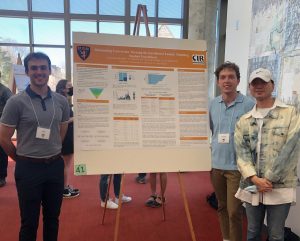 Domain Expert: Chris George (Enrollment), Dave Wagner (Admissions), Katie Warren (Marketing & Communications)
Domain Expert: Chris George (Enrollment), Dave Wagner (Admissions), Katie Warren (Marketing & Communications)
Stats/DS Mentor: Joe Roith
CIR Fellows: Caleb Griffiths, Alexander Matoushek, Chan Jin Park
Description: Enrollment offices at colleges and universities have an interest in identifying factors that contribute or hinder a student moving through the enrollment process (‘funnel’). Each year St. Olaf acquires nearly 200,000 student names (prospects) and begins an awareness marketing campaign to identify students who would like to learn more about the College (inquiries). At the start of their senior year, we encourage our 25,000+ inquiries to apply for admission. We typically have more than 6,000 applicants, from which we admit 2,700 to 3,000 students, with nearly 800 of these students choosing to enroll.
The pandemic has greatly altered how all college and university admissions offices are able to identify high school students who may be interested in attending their institution. As a result, identifying the most successful tactics and activities to move a student through the enrollment funnel will allow us to maximize both the time and resources to achieve our enrollment goals. We have a solid understanding of the tactics and activities that help us convert admitted students into enrolling students, but we believe there may be opportunities to improve conversion rates between the prospect to inquiry stage and the inquiry to applicant stage.
Data for this project will come primarily from Slate, our customer relationship management (CRM) tool. We have demographic, geographic, inquiry source, interaction, and enrollment funnel progression data. We also have access to national benchmark data (MarketView) through a data sharing consortium that we are a member of. Learning more about the students who convert, along with the activities and tactics that drive the conversion through the enrollment funnel will help streamline our process, maximize our financial and human resources, and position St. Olaf to thrive at a time (2026 and beyond) when the number of domestic high school graduates will significantly decrease.
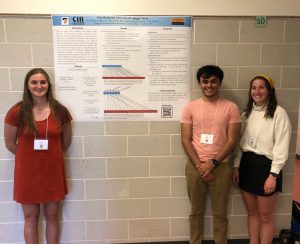 Title: Identifying the network of colleges’ peers
Title: Identifying the network of colleges’ peers
Domain Expert: Allison Luedtke (Economics)
Stats/DS Mentor: Jaime Davila
CIR Fellows: Ben Anderson, Kaya Gendreau, Lucia Ranallo
Description: Colleges and universities often look to their peers when making difficult decisions. For example, when schools were deciding how to open in Fall 2020 in the face of challenges created by the Coronavirus pandemic, there is evidence that schools were more likely to open in person if one of their peers opened in person. The same is true for schools opening remotely or in a hybrid format. These peer connections create a network of schools through which important decisions and information can travel.
What does this network look like? Which are the schools with the most peers? Which are the schools with the least? Are these peer schools competing for students? Can we dissect this network into competing peers and aspirational peers? Clearly, the peer connections that exist between schools are important for the choices these schools make. We will use data describing self-reported peers from schools throughout the United States, as well as data describing where schools are competing for students, to analyze these questions.
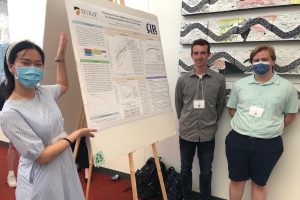 Title: Toward a better understanding of Buntrock Commons and New Student Orientation
Title: Toward a better understanding of Buntrock Commons and New Student Orientation
Domain Expert: Brandon Cash (Office of Student Activities)
Stats/DS Mentor: Paul Roback
CIR Fellows: Noah Johnson, Gabe Smith, Jazmine Sun
Description: The Buntrock Commons and Office of Student Activities team is responsible for a number of student-centered resources and experiences at St. Olaf. This project will aid in cultivating a better understanding of two of those areas: Buntrock Commons and New Student Orientation.
Buntrock Commons
The purpose of a Commons on a college campus is to advance a sense of community, unifying the institution by embracing the diversity of students, staff, faculty, alumni, and guests. Serving as the heart of our campus community, the mission of Buntrock Commons is to bolster the educational mission of St. Olaf and the development of students as lifelong learners by delivering an array of programs, services, and facilities. With the goal of fostering a “campus living room” feel, Buntrock Commons aims to enhance the student experience while cultivating an enduring connection to St. Olaf College.
Constructed in 1999 at the “crossroads” of the St. Olaf Campus, Buntrock Commons has seen numerous changes over the past two decades without much input from students. As such, the Buntrock Commons team administered a campus-wide assessment in the Spring of 2021 to garner student feedback, resulting in over 1000 responses. This project will look at the ways that students navigate Buntrock Commons with regard to its physical and digital spaces, the services it provides, and the support offices it houses in order to provide both a better understanding of the student experience and to identify opportunities for improvement. Students will review quantitative and qualitative responses to the 2021 survey in the aggregate and through various demographic lenses to assist the Commons team in making data-driven decisions on how to enhance the Buntrock experience.
New Student Orientation
The journey to college is often defined by a series of transitions across social and academic domains. The process of selecting and matriculating at an institution of higher learning can prove difficult for most incoming and/or transfer students due to the newness of a campus community, its curriculum, and its policies and procedures, thus establishing the need for intentional campus-specific orientation experiences. At St. Olaf, New Student Orientation (NSO) introduces incoming Oles to our community and provides the tools to navigate their academic and co-curricular experience while living in a vibrant residential community.
Refreshed and rebranded over the past two years, NSO has been designed to provide an engaging experience for students both over the summer and once they arrive on campus. In this project, students will analyze longitudinal data from four different windows during a new student’s orientation experience (Summer Module Pre-Assessment, Summer Module Post-Assessment, NSO Post Assessment, New Student Transition Survey) to better understand how students transition to St. Olaf, which elements of the NSO and St. Olaf experiences are most effective at facilitating a strong and successful transition, and identifying trends in a student’s sense of belonging at St. Olaf throughout the summer and first six weeks on campus. Results from the project will be used to inform future orientation experiences for both incoming first-year and transfer students as well as highlight opportunities to better support sophomore students in their ongoing transition through college.
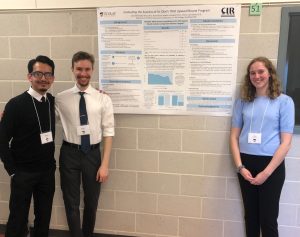 Title: Evaluating the success of St. Olaf’s TRIO programs
Title: Evaluating the success of St. Olaf’s TRIO programs
Domain Expert: Heather Campbell (Education)
Stats/DS Mentor: Sharon Lane-Getaz
CIR Fellows: Noah Elbaor, Clare McDonald, Marco Ruiz
Description: TRIO, established in 1965, were part of the “Great Society” programs Lyndon Johnson supported to address poverty. Still going strong in 2021, TRIO now includes multiple programs, including three hosted by St. Olaf: Upward Bound (UB), McNair, and Student Support Services (SSS). These federally-funded programs are designed to support students from families experiencing poverty who would be the first generation in their families to obtain a college degree along with students who are underrepresented in higher education.
What have been the outcomes of St. Olaf’s TRIO programs? Did TRIO program alumni obtain their educational goals? What factors might predict successful educational outcomes? This project will review student data for SSS (at St. Olaf since 1977), UB (at St. Olaf since 1989), and McNair (at St. Olaf since 2007) to answer these questions, working with and presenting to directors of these programs.
Related report: Indicators of higher education equity in the United States from the Pell Institute
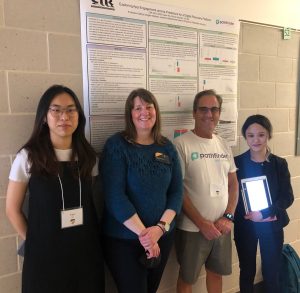 Title: Measuring engagement and recovery impact of a digital support platform
Title: Measuring engagement and recovery impact of a digital support platform
Domain Experts: David Wellstone and Jeramie Hildenbrand (Pathfinder Solutions)
Stats/DS Mentor: Katie Ziegler-Graham
CIR Fellows: Bryce Gmyrek, Yuzi Mi, Claire Wu
Description: Face to face support structures and social networks have been shown to be positively associated with recovery treatment outcomes in substance abuse disorders. Within this area, researchers have noted a dose-response effect — higher levels of engagement are associated with better recovery outcomes. As social networks along with clinical and emotional support move to digital platforms, participant engagement is not well understood. This project aims to explore and quantify engagement of participants of digital recovery support services (alongside traditional methods of treatment).
Students will work with a community partner trying to improve treatment for substance abuse disorders. Specifically, we seek to investigate (1) how levels of engagement change over time, (2) the variation in the type of engagement depending on the stage of recovery, and (3) quantifying the strength of specific relationships (counselor, peer, resource specialist) at various stages of recovery. The long-term goal of this project is to determine whether the addition of digital recovery support services improves treatment and recovery outcomes.
Related reading: Ashford, Robert D., et al.
“Digital recovery networks: Characterizing user participation, engagement, and outcomes of a novel recovery social network smartphone application.” Journal of substance abuse treatment 109 (2020): 50-55.
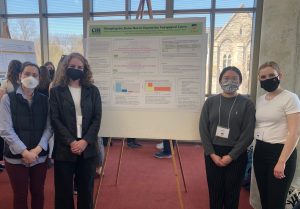 Title: Disrupting the status quo to expand music performance curriculum
Title: Disrupting the status quo to expand music performance curriculum
Domain Expert: Emery Stephens (Music)
Stats/DS Mentor: Laura Boehm Vock
CIR Fellows: Belkys Arbizu, Emma Dougherty, Grace Lofstrom
Description: It is a fact that in our colleges, universities, and conservatories, by and large, the canon of classical music is underrepresented by composers of color, a trend that holds for singers as well as instrumentalists. There remain concerns about equity and inclusion in higher education, specifically around the minimization of non-dominant identities, such as BBIA (Black, Brown, Indigenous, and Asian) voices.
This project should appeal to students interested in race and ethnic studies, social justice, and/or classical music, in addition to statistics and data science. Building on activities from the 2021 CURI summer project, “Amplifying Composers of Color: Decentering Whiteness in the American Art Music Canon,” students will be responsible for conducting a cross-analysis of results from an African American Art Song Survey (2005) and a 2021 CURI research project to understand the common themes and insights in both data sets. Students will use Google Forms to create a survey questionnaire for 20 to 25 predominantly white institutions (PWIs), including St. Olaf College, on the ratio of instrumental repertoire by white and composers of color. Primary data, such as the composer’s name, nationality, and racial identity will be documented in spreadsheets and subsequently analyzed in R. Some questions of inquiry include:
- Why does the study and performance of works centering on non-white cultural histories matter during the nation’s current examination of racial equality in America?
- What are the benefits of increased representation of composers of color in classical music?
- What is the ratio of assigned music repertoire by racial identities? For example, 90% white and 10% African American.
- How do students value the inclusion of such works by composers of color?
Students will develop quantitative results, including possible text analysis, to inform survey design and insights to the questions above. This project will help the music department design more diverse voices in the performance curriculum and contribute to higher education in general for greater diversity, equity, and opportunity.
Related readings:
Diversifying the playing field: solo performance of African American spirituals and art songs by voice students from all racial backgrounds
That sound you’re hearing is classical music’s long overdue reckoning with racism
You must be logged in to post a comment.